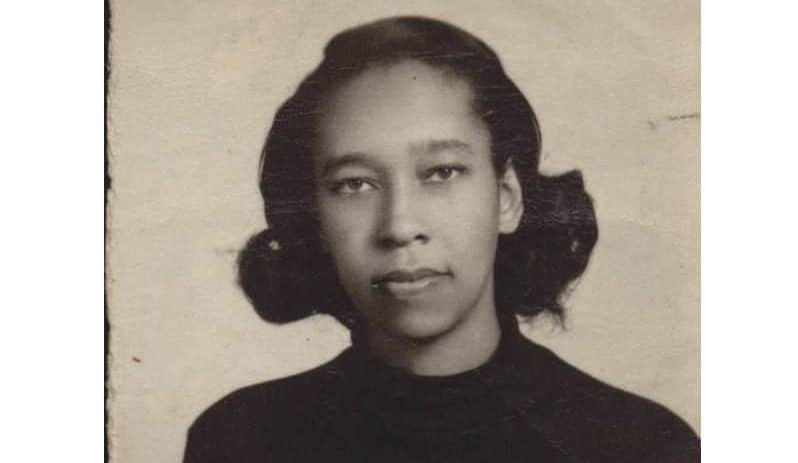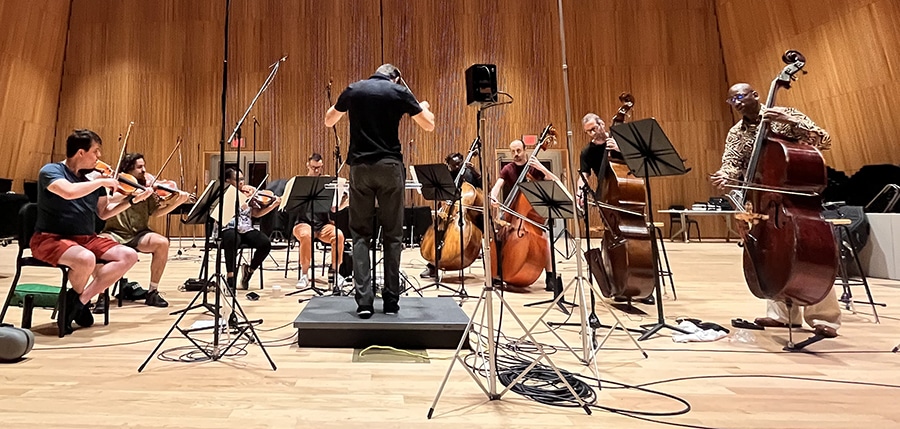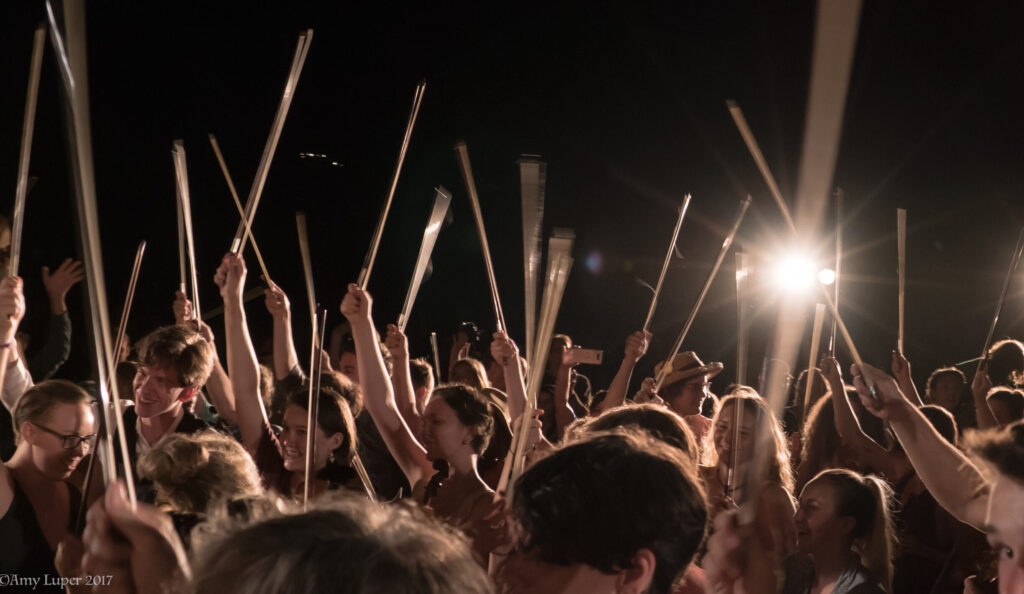A World with All These Pieces
The rediscovery of Julia Perry’s chamber music upends expectations and reveals glittering gems.
By Garrett Schumann

Swirling, tremulous, anguished, pointed, spacious, comical, dramatic, warm—all these words and more came to mind when I heard Julia Perry’s chamber music played in mid-March at the New School’s Tishman Auditorium in Manhattan. In the middle of a four-day Centenary Celebration & Festival in honor of Perry—a singular composer whose repertoire and legacy had until very recently faded into obscurity—was a concert focused squarely on Perry’s chamber music. Its program shifted from tender to turbulent and back. Here were rich and ominous counterpoint, minimalist textures, and oblique, dissonant harmonies. These compositions were all between 50 and 70 years old, yet they sounded new. And in one respect—in terms of their near total absence from stages and discourse for decades—they were.
Perry made her mark at a time when few Black women were represented among classical music’s ranks. Her career soared in the 1950s and early ‘60s, as she won multiple Guggenheim Fellowships, led European orchestral tours, and saw her music performed at Carnegie Hall. Yet by 1965, her career began an irreversible decline. At a time when unmarried Black women faced enormous socio-economic obstacles, Perry struggled with illness and financial difficulties that proved too great to overcome. Save for the dedicated attention of a small and disparate group of scholars and musicians, her music and her story became a footnote in American cultural history.
The March Centenary Festival— organized by Louise Toppin, professor of voice at the University of Michigan and founder of the African Diaspora Music Project, and conductor James Blachly of the Experiential Orchestra—offered a landmark moment (a series of them, actually) in commemoration of Perry’s 100th birthday. The Tishman Auditorium performances highlighted the latest developments in decades-long efforts to recover Perry’s compositions and to restore her legacy. One could sense the excitement and affection in the hall for this captivating composer whose works have been shrouded in a deep, posthumous silence.

A spectacular company of musicians presented a program of five works written between 1954 and 1976, the heart of Perry’s career, encompassing an extraordinarily varied range of material. Aside from this music’s beauty and rigor were clues to Perry’s life and work as well as one central truth: chamber music is the heart of her voice as a composer Flutist Brandon Patrick George floated tones in, above, and around plaintive, languid lines from a string sextet in Pastoral, composed in 1959, which represents the dissonant, contrapuntal, and dramatic style Perry developed through her studies with Italian modernist Luigi Dallapiccola in the 1950s. Six Contrasts, composed in 1954, showcased Perry’s broad stylistic range within a single offering. Here was plainly beautiful material that recalled Perry’s voluminous vocal music. Yet, dissonance also pervaded the piece, both in the piano accompaniment and in the lingering, unfolding vocal lines, which baritone Will Liverman expertly performed. Bass-baritone vocalist Donnie Ray Albert sang the world premiere of Quinary Quixotic Songs. Written in 1976, Perry’s last productive year as a composer, the piece featured unique instrumentation—voice, flute, clarinet, piano, euphonium, and viola—yet the resulting sound was nearly orchestral. Texture dominated in the accompaniment, melody existed only in small fragments, and harmony seemed mostly an afterthought. An extended passage of repeated, layered arpeggios in the accompaniment of the movement “‘Rock’ Soliloquy,” reminded me of iconic minimalist works like Philip Glass’s Einstein On The Beach and Nixon In China.
Symphony No. 13 for Wind Quintet, the final work on the program, also from 1976, resembled Quinary Quixotic Songs in its unusual instrumentation—Perry substituted saxophone for the wind quintet’s customary French horn. Its constantly shifting textures were both powerful and abstract, demonstrating Perry’s absolute control of sound itself, and her ability to build drama and a sense of surprise. “It is utterly unique in the chamber music repertoire,” bassoonist Brad Balliett, of the Experiential Orchestra, told me about the piece after performing it. “There are moments in which the combined instruments seem to burst their sonic seams.”
I came to Julia Perry’s music around 2017, through Janice Y. Wilson’s 1971 master’s thesis, “Black Serious Composers.” At the time, I was working as an educator and leading a Michigan-based presenting organization. In both roles, I sought to highlight historically excluded composers. I happened upon Wilson’s thesis through my own research, and it opened me up to other enlightening studies of Perry’s life and works by musicologists Mildred Denby Green and Helen Walker-Hill.
I immediately looked for recordings of Perry’s music. The first piece I listened to was Stabat Mater, a 1951 work for contralto and strings that is the most often- performed work of her repertoire. I was struck by its mixture of atonal and traditional classical music aesthetics. From Stabat Mater alone, I knew that Perry was an exceptional mid-century American Modernist. I was eager to hear as much of her music as possible, but I soon discovered that there were only a few reliable recordings of her compositions, along with a handful of performance videos on YouTube. At the time of Perry’s death in 1979, only three of her pieces—Stabat Mater, Homunculus C.F. (1961), and Short Piece for Orchestra (1952)—had been commercially recorded. Several notable works of hers, including the Boulanger Grand Prix-winning Viola Sonata, remain lost. Her published catalog represents only a small fraction of her total output, much of which exists as manuscripts.
Perry was a highly accomplished composer: In addition to awards from the Guggenheim Foundation and the Conservatoire Americain, she earned honors from National Institute of the Arts and Letters and enjoyed eight MacDowell residencies. Aaron Copland admired her music so much that he featured her at the Columbia University Composers Forum three times, and her works were performed at major American venues including Lincoln Center’s Alice Tully Hall and Philharmonic Hall auditoriums. Perry studied at Westminster Choir College, Juilliard, and Tanglewood before traveling to Europe to study with Nadia Boulanger and with Dallapiccola. But indigence, illness, and her outsider status as a minority-identity female composer in American classical music all figured into the muting of her career. Despite being recognized as one of the most talented American composers of her generation, she died in obscurity at the age of 55.
After her death, the scholars and performers who took up the arduous task of restoring Perry’s legacy faced enormous challenges in locating her scores and preparing them for other musicians’ use. Even so, there has been a resurgence of interest in Perry’s orchestral music of late. The celebrated Finnish conductor Susanna Mälkki has programmed Short Piece for Orchestra regularly since 2019. In the past year, The Cleveland Orchestra, Minnesota Orchestra, and New York Philharmonic all programmed works by Perry. And in 2024, stimulated by her centenary, a restorative project involving dozens of committed scholars, musicians, and musicologists in the United States and Europe has borne fantastic fruit: an unprecedented number of performances of Perry’s music around the world.
A comprehensive catalog of Perry’s compositions similarly emerged only recently, thanks to the work of independent scholars, the Akron Symphony Orchestra, and nonprofits like Toppin’s African Music Diaspora Project. It is not an exaggeration to say that Blachly and Toppin’s New York City programming simply would not have been possible even a few years ago. For instance, the reconstructed edition of Perry’s Violin Concerto performed by Blachly, the Experiential Orchestra, and violinist Curtis Stewart at Alice Tully Hall on the Centenary’s final night was not completed until last September.
This renewed attention is a welcome development, but the rush to present Perry’s orchestral repertoire risks overshadowing her distinctive and important chamber music. It’s worth noting that many of Perry’s most prestigious achievements specifically connect to her chamber repertoire. Stabat Mater, which was frequently performed with soloist and string quartet, was Perry’s first career breakthrough, and it helped her secure the two Guggenheim Fellowships that earned her international attention. She also composed Pastoral, Six Contrasts, the stand-alone song Parody (1954), and other chamber pieces during her many MacDowell residencies. The greatest champions of Perry’s music during her life were chamber musicians, namely singers like Betty Allen, Ellabelle Davis, and Adele Addison.
If Perry’s chamber compositions provide a fresh and highly detailed account of her musical sensibilities, they also trace the contours of her biography. Perry was born in Lexington, Kentucky, on March 25, 1924, and moved to Akron, Ohio while still young. She spent her childhood there in a household full of music, and developed a reputation as a talented vocalist that drew the attention of local newspapers. During one of the Centenary festival’s lectures, Akron Symphony music director Christopher Wilkins shared an interview with one of Julia Perry’s childhood neighbors, who described the future composer as an introverted child, absorbed in her music studies.
These characteristics endured into Perry’s adulthood, but archival audio from a 1954 post-concert talk at Columbia University also reveals a winning charm. Seated onstage between Aaron Copland, the concert’s host, and George Antheil, the other composer on the evening’s program, Perry sounds like a comfortable peer whose quick wit draws laughter from the audience. When Copland asks her if she wants to teach, she says, “Well, if I can get around it, no.” Her sense of humor sometimes infused her music, as in the absurdist movement “Ghosts for Sale,” from Six Contrasts and Parody, which uses a half-sung, sprechstimme vocal technique alongside lilting piano to achieve a theatrical, comic feeling.
The percussion chamber ensemble work Homunculus C.F., which she wrote in an apartment above the office of her father, who was a physician in Akron, Ohio, shows both an intersection of her life and music and that same lightheartedness. As Perry explained in a program note: “These clinical surroundings evoked memories of the Medieval laboratory where Wagner, youthful apprentice to Faust, made a successful alchemy experiment, fashioning and bringing to life a creature he called Homunculus.” Other scores of hers are embedded with clues about her thinking regarding instrumentation and her circumstances. For example, the manuscript for Prelude for Piano (1946) notes an optional string arrangement that has never been found, and the manuscript for Serenity indicates that it can be played by solo oboe or clarinet.
Perry’s works reveal determination and industriousness. She composed vigorously and was just as keen to make practical choices in her work as she was to be idiosyncratic. The unusual instrumentation of the late works Symphony No. 13 and Quinary Quixotic Songs suggests that, by that point, she was writing for the instrumentalists she could find in Akron (at one point in 1976, she and her mother sent scores to the University of Akron School of Music with the hope that students there would play her compositions). There are three arrangements of Study for Orchestra, a 1964 revision of her 1952 work, “A Short Piece for Orchestra,” each of which fits a specific different performance opportunity. There are also several works—Pastoral, Quinary Quixotic Songs, Symphony No. 13, and A Short Service (1955), which is scored for trumpet and tenor soloist, to name a few—whose unique instrumentations betray such pragmatism.

Perry’s determination was especially evident in her final years. She suffered a debilitating stroke in the early 1970s that left the right side of her body paralyzed, after which she taught herself to write with her left hand so that she could continue composing. As a result, the manuscripts for Serenity and the other works she created in the last productive years of her career are often inscrutable and self-consciously amended with the names of notes written above her crudely scrawled melodies. Perry understood that future performers, publishers, and conductors would not be able to read her handwriting, yet she soldiered on, creating new music.
Other illnesses could also have played a role in limiting her career long before her stroke. And the death of her father in the early 1960s may have had the greatest negative impact. Abe Perry was a noted doctor and talented pianist who supported his daughters as much as possible. After his passing, Julia was forced to support her mother, America Perry, along with herself. Throughout the 1950s, she split her time between New York City, where she organized concerts of her music, and Europe, where she conducted orchestral tours for the United States government. But, in the 1960s, her health and family obligations prevented her from maintaining this robust work schedule.
Despite Perry’s impressive awards, she struggled to earn money through her commissions and other musical activities. In April 1962, she ran a classified ad in the New York Amsterdam News that listed her achievements as a “distinguished musician—winner of two Guggenheim Fellowships and conductor of European orchestras,” to announce the opening of a new teaching studio, something we know she had hoped to avoid. Perry’s correspondence with the New York Philharmonic during their 1964-65 season, when the ensemble programmed her Study for Orchestra, reveals her dire circumstances at the time. The Philharmonic performed the composition on three consecutive nights—May 6, 7, and 8—but Perry was absent because she could not afford to travel. On May 29, 1965, she sent Carlos Moseley, the New York Philharmonic’s managing director, a telegram reading, “unemployed at this time, I am without the barest essentials.”
All evidence indicates that Perry lived the remaining fourteen years of her life in Akron. In addition to her desperation, the details of her collaboration with the Philharmonic point to other factors—the sort of frustrations that affected many Black American artists at that time—that shaped her career’s reclusive final chapter. In addition to solicitations for more performances and conducting gigs, her correspondence with Philharmonic staff conveys her attempts to convince conductors Leonard Bernstein and William Steinberg to program a new work entitled Liberation for Orchestra instead of Study. Perry describes Liberation as the same length and instrumentation as Study and inspired by the Civil Rights Movement, but the orchestra demurred at the chance to perform a political work by a Black composer. That same year, 1965, Perry wrote an unpublished poem, Graves of Untold Africans, which, according to scholar Tad Biggs, “laments the loss of a rich and varied African culture.”
None of Perry’s earlier work engages as explicitly and directly with her identity and position as an African-American, as did Liberation. Though there is no singular, summarizing anecdote illustrating Perry’s experiences with racism, there is considerable evidence that despite her awards and performances she struggled enormously to gain acceptance from the white mainstream in American classical music. For example, the only newspaper to publish an obituary marking her death was the New York Amsterdam News, a Black-owned publication; and, despite occasional fond coverage from The Christian Science Monitor and The New York Times in the 1940s and 50s, it was largely Black media that consistently supported her in the final phase of her career. Her experiences in the 1960s, specifically her decision in 1965 to leave New York City, the sphere of influence for so many major white-led American arts institutions, remains an area of Perry’s biography that requires further study.
When Perry died on April 24, 1979, she was survived by her mother but had no heirs. Lacking an estate to posthumously manage her catalog, the copyright status of many works grew murky. As Christopher Wilkins explained in a lecture at the Centenary Celebration, he and the Akron Symphony Orchestra spent years attempting to find and contact Perry’s surviving family members with little success. Eventually, they began working with the local probate court to clarify these intellectual property ambiguities through pathways outlined in Ohio state law. Wilkins also explained other complications with Perry’s manuscripts, many of which require transcription to be performed.
The Centenary Celebration’s other lectures focused on new analysis and documentation of Perry’s life and music, particularly with respect to her identity. Louise Toppin designed the festival’s scholarly events to cultivate such research and discussion, as well as to support future performances. Toppin’s nonprofits, Videmus and The African Diaspora Music Project, have taken on the tedious task of cataloging Perry’s music and engraving her manuscripts. These endeavors have already produced new scores for works like Serenity, Quinary Quixotic Songs, and Symphony No. 13 for Wind Quintet, and there is an expectation to publish more when Perry’s copyright impasse is resolved.

Julia Perry’s music clearly grabs people with force enough for generations of scholars and musicians to have spent decades painstakingly building the foundation from which her music now vaults to center stage. As someone who has studied and presented dozens of Perry’s works, I hear her compositions as astounding testimonies to a singular musical vision, as well as poignant revelations on American musical history. And they amount to something more—a synthesizing and clarifying voice. The common narratives describing 20th-century classical music in the United States are largely divisive along stylistic lines: Modernism conflicts with tonality; Minimalism stands against complexity; consonance and dissonance belong to different ideological camps. Yet Julia Perry defies such frameworks. Her music welcomes virtually every so-called faction of twentieth-century American composition, each respected and represented through her inimitable skill and ingenuity. This quality is clearest through her chamber music.
Her works spark both awe and fascination in many musicians. “There’s something very distinctive about Perry’s harmonic palette,” cellist Hamilton Berry of PUBLIQuartet, who wrote the string quartet arrangement of Miniature for Piano played at the Centenary Celebration’s opening concert, said in an email. After the Cincinnati Symphony Ochestra performed Homunculus C.F. during a November 2021 program, music director Louis Langrée said that the piece “creates a kind of incandescence with its structure and expression.” James Blachly told me in an interview, “The only other composer who strikes me with the same strength of spirit and commitment to process is Beethoven.”
In June, Samantha Ege appeared as soloist alongside the London-based ensemble Lontano on the first-ever commercial release, due in October, of Perry’s Concerto No. 2 For Piano and Orchestra in Two Uninterrupted Speeds (composed in 1965, and revised several times through 1969). For the March Centenary’s opening concert at Manhattan’s (Le) Poisson Rouge, which also focused on Perry’s chamber music, Ege performed Perry’s Prelude as well as Miniature (from 1972). “The Prelude has signature dissonances, which are these intervals of a second that she puts together,” Ege said. “And they don’t crunch, they just elide, it’s so smooth and beautiful.” Miniature, on the other hand, features explosive rhythms, sparse textures, and angular lines: a wholly divergent approach to dissonance.
Soprano Laquita Mitchell joined Ege that night to perform By The Sea (1950), a staple of Perry’s career that appeared on multiple soloists’ tours in the 1950s, on national radio broadcasts, and even made it to Carnegie Hall in 1970. By The Sea—a dreamy piece with tender vocal melodies supported by an undulating piano part—offers an exceptional portrait of Perry’s musical voice, especially her complementary perspectives on dissonance and consonance.
Yet for Ege, such analyses may be beside the point. “Perry is not thinking in terms of melody or harmony,” she said, “she’s thinking in terms of a universe. She is building a world with all these pieces, and she doesn’t waste anything.”


